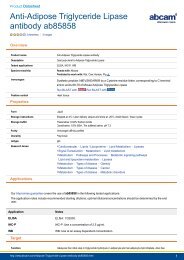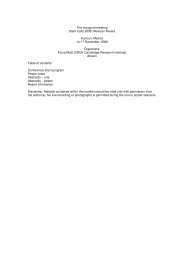Anti-Sclerostin antibody (ab85799) (ab85799) - Abcam
Anti-Sclerostin antibody (ab85799) (ab85799) - Abcam
Anti-Sclerostin antibody (ab85799) (ab85799) - Abcam
You also want an ePaper? Increase the reach of your titles
YUMPU automatically turns print PDFs into web optimized ePapers that Google loves.
<strong>Anti</strong>-<strong>Sclerostin</strong> <strong>antibody</strong> (<strong>ab85799</strong>)<br />
2 Images URL for this product: http://www.abcam.com/<strong>Sclerostin</strong>-<strong>antibody</strong>-<strong>ab85799</strong>.html<br />
Product overview<br />
Description Rabbit polyclonal to <strong>Sclerostin</strong><br />
Host species Rabbit<br />
Tested applications WB, ICC/IF<br />
Cross reactivity Reacts with<br />
Human<br />
Predicted to work with<br />
Mouse, Rat, Cow, Dog, Pig<br />
Immunogen Synthetic peptide conjugated to KLH derived from within residues 100 - 200 of Human <strong>Sclerostin</strong>.(Note: the amino acid sequence is<br />
proprietary)<br />
Positive control This <strong>antibody</strong> gave a positive signal in Human bone tumour tissue lysate.<br />
Target<br />
Function Negative regulator of bone growth.<br />
Tissue specificity Widely expressed at low levels with highest levels in bone, cartilage, kidney, liver, bone marrow and primary osteeoblasts differentiated<br />
for 21 days.<br />
Involvement in disease Defects in SOST are the cause of sclerosteosis (SOST) [MIM:269500]; also known as cortical hyperostosis with syndactyly. SOST is an<br />
autosomal recessive sclerosing bone dysplasia characterized by a generalized hyperostosis and sclerosis leading to a markedly<br />
thickened skull, with mandible, ribs, clavicles and all long bones also being affected. Due to narrowing of the foramina of the cranial<br />
nerves, facial nerve palsy, hearing loss and atrophy of the optic nerves can occur. Sclerosteosis is clinically and radiologically very<br />
similar to van Buchem disease, mainly differentiated by hand malformations and a large stature in sclerosteosis patients.<br />
Note=A 52 kb deletion downstream of SOST results in SOST transcription suppression and is a cause of van Buchem disease (VBCH)<br />
[MIM:239100]; also known as hyperostosis corticalis generalisata. VBCH is an autosomal recessive sclerosing bone dysplasia<br />
characterized by endosteal hyperostosis of the mandible, skull, ribs, clavicles, and diaphyses of the long bones. Affected patients<br />
present a symmetrically increased thickness of bones, most frequently found as an enlarged jawbone, but also an enlargement of the<br />
skull, ribs, diaphysis of long bones, as well as tubular bones of hands and feet. The clinical consequence of increased thickness of the<br />
skull include facial nerve palsy causing hearing loss, visual problems, neurological pain, and, very rarely, blindness as a consequence of<br />
optic atrophy. Serum alkaline phosphatase levels are elevated.<br />
Sequence similarities Belongs to the sclerostin family.<br />
Contains 1 CTCK (C-terminal cystine knot-like) domain.<br />
Cellular localization Secreted.<br />
Target information above from: UniProt accessionQ9BQB4 The UniProt Consortium<br />
The Universal Protein Resource (UniProt) in 2010<br />
Nucleic Acids Res. 38:D142-D148 (2010).<br />
Alternative names BEER <strong>antibody</strong><br />
Cortical hyperostosis with syndactyly <strong>antibody</strong><br />
Sclerosteosis <strong>antibody</strong><br />
<strong>Sclerostin</strong> <strong>antibody</strong><br />
SOST <strong>antibody</strong><br />
SOST_HUMAN <strong>antibody</strong><br />
VBCH <strong>antibody</strong><br />
Properties<br />
UK office:<br />
<strong>Abcam</strong> plc<br />
330 Cambridge Science Park Cambridge CB4 0FL UK<br />
Tel: +44 (0)1223 696000<br />
Fax: +44 (0)1223 215 215<br />
Email: orders@abcam.com<br />
US office:<br />
<strong>Abcam</strong> Inc.<br />
1 Kendall Square, Suite B2304 Cambridge, MA 02139-1517 USA<br />
Tel: (888) 77-ABCAM (22226)<br />
Fax: (877) 774-8286<br />
These numbers are toll free in the US/Canada<br />
Email: us.orders@abcam.com<br />
Last updated on<br />
December 21, 2012
Form Liquid<br />
Storage instructions Store at +4°C short term (1-2 weeks). Aliquot and store at -20°C or -80°C. Avoid repeated freeze / thaw cycles.<br />
Storage buffer pH: 7.40<br />
Preservative: 0.02% Sodium azide<br />
Constituents: 1% BSA, PBS<br />
Note: Batches of this product that have a concentration < 1mg/ml may have BSA added as a stabilising agent. If you would like<br />
information about the formulation of a specific lot, please contact our scientific support team who will be happy to help.<br />
See the website for more SDS information for this product.<br />
Purity Immunogen affinity purified<br />
Clonality Polyclonal<br />
Isotype IgG<br />
Applications<br />
WB WB: Use a concentration of 1 µg/ml. Detects a band of approximately 28 kDa (predicted molecular weight: 24 kDa).<br />
ICC/IF ICC/IF: Use a concentration of 5 µg/ml.<br />
Images (See the website for higher resolution images of this product)<br />
<strong>Anti</strong>-<strong>Sclerostin</strong> <strong>antibody</strong> (<strong>ab85799</strong>) at 1 µg/ml + Bone (Human) Tissue Lysate - tumor tissue (ab29359) at 10 µg<br />
Secondary<br />
Goat polyclonal Secondary <strong>Anti</strong>body to Rabbit IgG - H&L (HRP), pre-adsorbed (ab97080) at 1/5000 dilution<br />
developed using the ECL technique<br />
Performed under reducing conditions.<br />
Predicted band size : 24 kDa<br />
Observed band size : 28 kDa (why is the actual band size different from the predicted?)<br />
Additional bands at : 150 kDa,55 kDa. We are unsure as to the identity of these extra bands.<br />
Exposure time : 20 minutes<br />
Our Abpromise to you: Quality guaranteed and expert technical support<br />
ICC/IF image of <strong>ab85799</strong> stained HepG2 cells. The cells were 4% PFA fixed (10 min) and then incubated in 1%BSA<br />
/ 10% normal goat serum / 0.3M glycine in 0.1% PBS-Tween for 1h to permeabilise the cells and block non-specific<br />
protein-protein interactions. The cells were then incubated with the <strong>antibody</strong> (<strong>ab85799</strong>, 5µg/ml) overnight at +4°C.<br />
The secondary <strong>antibody</strong> (green) was ab96899, DyLight® 488 goat anti-rabbit IgG (H+L) used at a 1/250 dilution for<br />
1h. Alexa Fluor® 594 WGA was used to label plasma membranes (red) at a 1/200 dilution for 1h. DAPI was used to<br />
stain the cell nuclei (blue) at a concentration of 1.43µM. This <strong>antibody</strong> also gave a positive result in 4% PFA fixed (10<br />
min) HeLa and MCF7 cells at 5µg/ml.<br />
If the product does not perform as described on this datasheet, we will offer a refund or replacement. For full details of the Abpromise, please visit<br />
http://www.abcam.com/abpromise or contact our technical team.<br />
UK office:<br />
<strong>Abcam</strong> plc<br />
330 Cambridge Science Park Cambridge CB4 0FL UK<br />
Tel: +44 (0)1223 696000<br />
Fax: +44 (0)1223 215 215<br />
Email: orders@abcam.com<br />
US office:<br />
<strong>Abcam</strong> Inc.<br />
1 Kendall Square, Suite B2304 Cambridge, MA 02139-1517 USA<br />
Tel: (888) 77-ABCAM (22226)<br />
Fax: (877) 774-8286<br />
These numbers are toll free in the US/Canada<br />
Email: us.orders@abcam.com<br />
Last updated on<br />
December 21, 2012









![Anti-Vinculin antibody [hVIN-1] (ab11194) - Abcam](https://img.yumpu.com/18933715/1/184x260/anti-vinculin-antibody-hvin-1-ab11194-abcam.jpg?quality=85)






